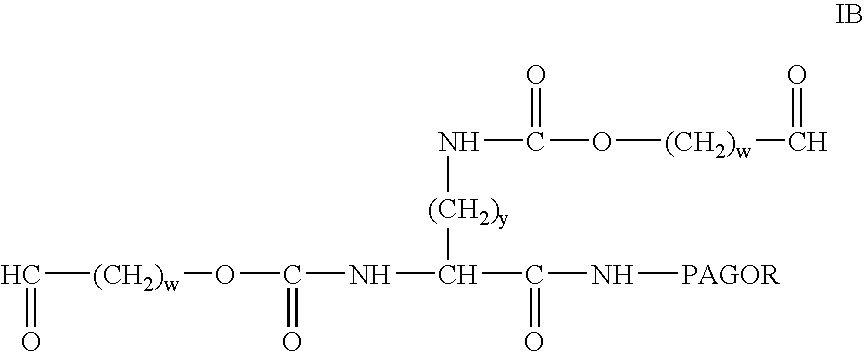Bifunctional polyethylene glycol derivatives
a polyethylene glycol and derivative technology, applied in the field of therapeutic proteins, can solve the problems of short in vivo half-life, difficult purification, and may not be desirable for pharmaceutical use, and achieve the effects of stable reagents, stable reagents, and stable reagents in the aqueous medium
- Summary
- Abstract
- Description
- Claims
- Application Information
AI Technical Summary
Benefits of technology
Problems solved by technology
Method used
Image
Examples
example 1
Scheme A (Type IA-1)
Synthesis of PEG-acetamide-propionaldehyde
[0188]Polyethylene glycol, HO-PEG-OH (M.W. 20,000, n=453)) 1 and potassium t-butoxide were dissolved in t-butyl alcohol and stirred at 60° C. Ethyl bromoacetate (2.5 moles) was then slowly added and the mixture stirred for 15 hours at 80–85° C. The reaction mixture was then filtered, and the solvent evaporated under reduced pressure. The residue was dissolved in distilled water, washed with diethyl ether, and extracted twice with dichloromethane. The dichloromethane solution was dried over magnesium sulfate and the solvent removed under vacuum. Precipitation was induced by the addition of diethyl ether to the crude residue and the precipitated compound was then filtered and dried under vacuum to give the product 2 as a white powder.
[0189]The PEG-diethyl acetate 2 was dissolved in 1 N-sodium hydroxide and stirred for 15 hours at room temperature. The reaction mixture was then adjusted to pH 2 with 1 N aqueous solution HCl ...
example 2
Scheme B (Type IA-1)
Synthesis of PEG-propionamide-butyraldehyde
[0194]To 10 g, (1 mmol) of polyethylene glycol dipropionic acid 1 (MW 10,000, n=224) dissolved in dry methylene chloride (30 ml) was added dry and finely powdered NHS (0.56 g, 5 mmol). The flask was cooled in an ice-water bath and DCC (0.44 g, 2.16 mmol) added. The reaction mixture was stirred at 0° C. for 1 h and at room temperature for 24 h. The precipitated 1,3-dicyclohexylurea (DCU) was removed by filtration, and the filtrate added to ether (50 ml). After cooling to 4° C. the crude material 2 was collected by filtration and purified by precipitating twice from methylene chloride by the addition of ether.
[0195]To the N-hydroxy succinate derivative 2 (8.5 g˜0.85 mmol) dissolved in dry methylene chloride (25 ml) there was added 1-amino-4,4-dimethoxybutane (3) (0.4 g, 2.5 mmol). The reaction mixture was stirred at room temperature for 2 h and the product precipitated in ether (100 ml). After cooling to 4° C. the crude ac...
example 3
Scheme C (Type IA-2)
Synthesis of PEG-urethane-propionaldehyde
[0197]Triphosgene in dichloromethane was added slowly to a solution of PEG (MW 20,000, n=453) 1 dissolved in dichloromethane and the resulting mixture stirred for 15 hours at room temperature. The organic solvent and excess phosgene were then removed from the reaction mixture under vacuum. The residue was redisolved in dichloromethane and treated with N-hydroxysuccinimide followed by trimethylamine. After 3 hours, the solution was filtered and evaporated to dryness. The residue was dissolved in warm (50° C.) ethyl acetate, and then the solution cooled to 0° C. The resulting precipitate 2 was collected as a white powder, and the product dried under vacuum.
[0198]To a solution of the PEG-succinimidylcarbonate 2 dissolved in dichloromethane was added 1-amino-3,3-diethoxypropane (3). The reaction mixture was then stirred for 2 hours at room temperature. Ether was then added and the resulting precipitate 4 collected and recrysta...
PUM
| Property | Measurement | Unit |
|---|---|---|
| molecular weight | aaaaa | aaaaa |
| molecular weight | aaaaa | aaaaa |
| molecular weight | aaaaa | aaaaa |
Abstract
Description
Claims
Application Information
 Login to View More
Login to View More - R&D
- Intellectual Property
- Life Sciences
- Materials
- Tech Scout
- Unparalleled Data Quality
- Higher Quality Content
- 60% Fewer Hallucinations
Browse by: Latest US Patents, China's latest patents, Technical Efficacy Thesaurus, Application Domain, Technology Topic, Popular Technical Reports.
© 2025 PatSnap. All rights reserved.Legal|Privacy policy|Modern Slavery Act Transparency Statement|Sitemap|About US| Contact US: help@patsnap.com



